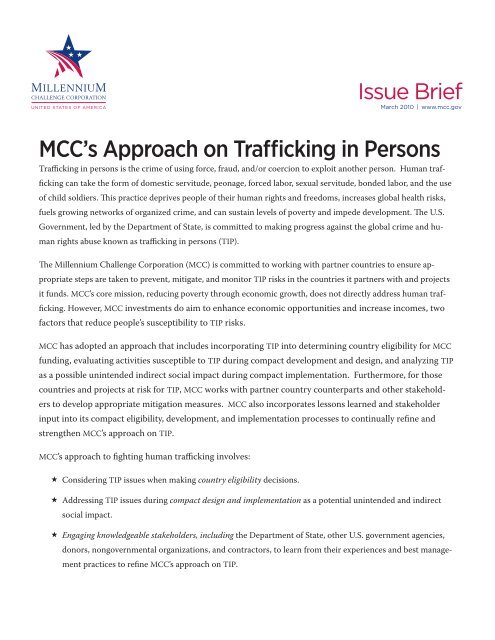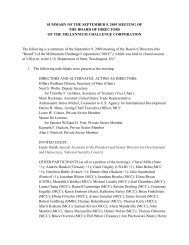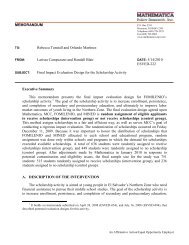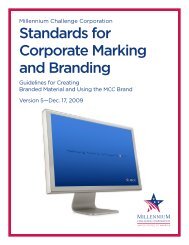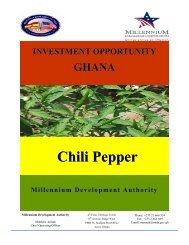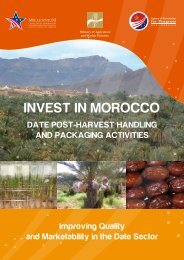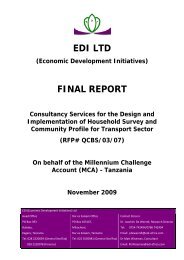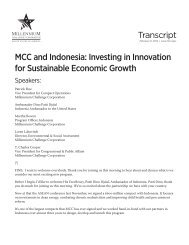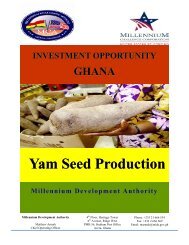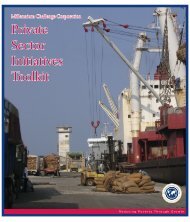Issue Brief: MCC and Trafficking in Persons, March 2010
Issue Brief: MCC and Trafficking in Persons, March 2010
Issue Brief: MCC and Trafficking in Persons, March 2010
Create successful ePaper yourself
Turn your PDF publications into a flip-book with our unique Google optimized e-Paper software.
<strong>Issue</strong> <strong>Brief</strong><br />
<strong>March</strong> <strong>2010</strong> | www.mcc.gov<br />
<strong>MCC</strong>’s Approach on <strong>Traffick<strong>in</strong>g</strong> <strong>in</strong> <strong>Persons</strong><br />
<strong>Traffick<strong>in</strong>g</strong> <strong>in</strong> persons is the crime of us<strong>in</strong>g force, fraud, <strong>and</strong>/or coercion to exploit another person. Human traf-<br />
fick<strong>in</strong>g can take the form of domestic servitude, peonage, forced labor, sexual servitude, bonded labor, <strong>and</strong> the use<br />
of child soldiers. This practice deprives people of their human rights <strong>and</strong> freedoms, <strong>in</strong>creases global health risks,<br />
fuels grow<strong>in</strong>g networks of organized crime, <strong>and</strong> can susta<strong>in</strong> levels of poverty <strong>and</strong> impede development. The U.S.<br />
Government, led by the Department of State, is committed to mak<strong>in</strong>g progress aga<strong>in</strong>st the global crime <strong>and</strong> hu-<br />
man rights abuse known as traffick<strong>in</strong>g <strong>in</strong> persons (TIP).<br />
The Millennium Challenge Corporation (<strong>MCC</strong>) is committed to work<strong>in</strong>g with partner countries to ensure ap-<br />
propriate steps are taken to prevent, mitigate, <strong>and</strong> monitor TIP risks <strong>in</strong> the countries it partners with <strong>and</strong> projects<br />
it funds. <strong>MCC</strong>’s core mission, reduc<strong>in</strong>g poverty through economic growth, does not directly address human traf-<br />
fick<strong>in</strong>g. However, <strong>MCC</strong> <strong>in</strong>vestments do aim to enhance economic opportunities <strong>and</strong> <strong>in</strong>crease <strong>in</strong>comes, two<br />
factors that reduce people’s susceptibility to TIP risks.<br />
<strong>MCC</strong> has adopted an approach that <strong>in</strong>cludes <strong>in</strong>corporat<strong>in</strong>g TIP <strong>in</strong>to determ<strong>in</strong><strong>in</strong>g country eligibility for <strong>MCC</strong><br />
fund<strong>in</strong>g, evaluat<strong>in</strong>g activities susceptible to TIP dur<strong>in</strong>g compact development <strong>and</strong> design, <strong>and</strong> analyz<strong>in</strong>g TIP<br />
as a possible un<strong>in</strong>tended <strong>in</strong>direct social impact dur<strong>in</strong>g compact implementation. Furthermore, for those<br />
countries <strong>and</strong> projects at risk for TIP, <strong>MCC</strong> works with partner country counterparts <strong>and</strong> other stakehold-<br />
ers to develop appropriate mitigation measures. <strong>MCC</strong> also <strong>in</strong>corporates lessons learned <strong>and</strong> stakeholder<br />
<strong>in</strong>put <strong>in</strong>to its compact eligibility, development, <strong>and</strong> implementation processes to cont<strong>in</strong>ually ref<strong>in</strong>e <strong>and</strong><br />
strengthen <strong>MCC</strong>’s approach on TIP.<br />
<strong>MCC</strong>’s approach to fight<strong>in</strong>g human traffick<strong>in</strong>g <strong>in</strong>volves:<br />
Consider<strong>in</strong>g TIP issues when mak<strong>in</strong>g country eligibility decisions.<br />
Address<strong>in</strong>g TIP issues dur<strong>in</strong>g compact design <strong>and</strong> implementation as a potential un<strong>in</strong>tended <strong>and</strong> <strong>in</strong>direct<br />
social impact.<br />
Engag<strong>in</strong>g knowledgeable stakeholders, <strong>in</strong>clud<strong>in</strong>g the Department of State, other U.S. government agencies,<br />
donors, nongovernmental organizations, <strong>and</strong> contractors, to learn from their experiences <strong>and</strong> best manage-<br />
ment practices to ref<strong>in</strong>e <strong>MCC</strong>’s approach on TIP.
Consideration of TIP <strong>in</strong> Country Eligibility<br />
<strong>MCC</strong> emphasizes the importance of tak<strong>in</strong>g measures to address TIP concerns when evaluat<strong>in</strong>g a potential partner’s<br />
policy performance <strong>and</strong> eligibility for an <strong>MCC</strong> compact or threshold program. <strong>MCC</strong> formally <strong>in</strong>tegrates the U.S.<br />
Department of State’s <strong>Traffick<strong>in</strong>g</strong> <strong>in</strong> <strong>Persons</strong> Report <strong>in</strong>to its selection process <strong>and</strong> uses the World Bank’s Rule of<br />
Law <strong>in</strong>dicator, an aggregate <strong>in</strong>dicator that considers human traffick<strong>in</strong>g as one of its factors, as a part of the selec-<br />
tion criteria. By law, a country determ<strong>in</strong>ed by the U.S. State Department to rank <strong>in</strong> Tier 3 <strong>and</strong> has had sanctions<br />
applied cannot be <strong>in</strong>cluded on <strong>MCC</strong>’s annual c<strong>and</strong>idate country list. For high-risk TIP countries, <strong>MCC</strong>’s Board<br />
of Directors reviews supplemental <strong>in</strong>formation on the TIP rank<strong>in</strong>gs <strong>and</strong> TIP-related practices, such as changes to<br />
regulations, enforcement <strong>and</strong> monitor<strong>in</strong>g requirements, <strong>and</strong> provisions made to protect victims of traffick<strong>in</strong>g.<br />
Address<strong>in</strong>g TIP <strong>in</strong> Compact Design <strong>and</strong> Implementation<br />
<strong>MCC</strong>’s Policy on Suspension <strong>and</strong> Term<strong>in</strong>ation governs cases of decl<strong>in</strong>e <strong>in</strong> the TIP rat<strong>in</strong>g of a partner country. In the<br />
case of such decl<strong>in</strong>es, <strong>MCC</strong> analyzes what triggered the change to determ<strong>in</strong>e whether it reflects a significant policy<br />
reversal or a pattern of actions <strong>in</strong>consistent with <strong>MCC</strong>’s selection criteria. Consistent with its Policy on Suspension<br />
<strong>and</strong> Term<strong>in</strong>ation, <strong>MCC</strong> provides warn<strong>in</strong>gs to countries that show a pattern of behavior <strong>in</strong>consistent with <strong>MCC</strong>’s<br />
selection criteria. If such warn<strong>in</strong>g letters are not acted upon, <strong>MCC</strong> may partially or fully suspend or term<strong>in</strong>ate a<br />
country’s eligibility to cont<strong>in</strong>ue develop<strong>in</strong>g or implement<strong>in</strong>g a compact or threshold program.<br />
Some development <strong>in</strong>vestments, <strong>in</strong>clud<strong>in</strong>g some funded by <strong>MCC</strong>, could <strong>in</strong>directly <strong>and</strong> un<strong>in</strong>tentionally contribute<br />
to adverse social impacts, <strong>in</strong>clud<strong>in</strong>g human traffick<strong>in</strong>g. Consequently, <strong>MCC</strong> addresses TIP, along with other<br />
potential project-related adverse social <strong>and</strong> environmental impacts, dur<strong>in</strong>g program design <strong>and</strong> implementation.<br />
Human traffick<strong>in</strong>g should be prevented where at all possible, mitigated if the risk rema<strong>in</strong>s, <strong>and</strong> monitored system-<br />
atically to verify the effectiveness of preventive measures.<br />
Project Design<br />
<strong>MCC</strong> assesses proposed compact projects to determ<strong>in</strong>e which projects could be most susceptible to TIP risks,<br />
for example:<br />
Large-scale construction works that have contractors <strong>and</strong> workers who may move <strong>in</strong> <strong>and</strong> out of areas, may<br />
cross or approach regional <strong>and</strong> <strong>in</strong>ternational borders, <strong>and</strong> may contribute to transport of persons vulnerable<br />
to TIP offenses.<br />
Large-scale l<strong>in</strong>ear projects such as roads, railroads, <strong>and</strong> pipel<strong>in</strong>es that may contribute to easier access or<br />
transport of potential victims of human traffick<strong>in</strong>g.<br />
<strong>MCC</strong> <strong>and</strong> <strong>Traffick<strong>in</strong>g</strong> <strong>in</strong> <strong>Persons</strong>, <strong>March</strong> <strong>2010</strong> 2
The establishment of worker camps for <strong>in</strong>frastructure projects <strong>in</strong> proximity to borders or vulnerable com-<br />
munities that may contribute to a higher risk of traffick<strong>in</strong>g.<br />
For such projects, <strong>MCC</strong> works with its partner countries to ensure that TIP risks are identified early as part of the<br />
<strong>in</strong>tegrated environmental <strong>and</strong> social impact assessment (ESIA) process. ESIA outputs are then used to optimize<br />
project design <strong>and</strong> to def<strong>in</strong>e any mitigat<strong>in</strong>g <strong>and</strong> monitor<strong>in</strong>g measures needed dur<strong>in</strong>g project construction <strong>and</strong><br />
subsequent operations.<br />
Project Implementation<br />
<strong>MCC</strong> has modified bidd<strong>in</strong>g documents for construction projects to help identify <strong>and</strong> reduce TIP risks <strong>in</strong>clud<strong>in</strong>g:<br />
rais<strong>in</strong>g contractors’ awareness; request<strong>in</strong>g contractors’ <strong>in</strong>put on TIP risks; <strong>and</strong>, where appropriate, requir<strong>in</strong>g<br />
contractors to embed TIP prevention <strong>and</strong> mitigation <strong>in</strong> their exist<strong>in</strong>g management systems, such as quality, health,<br />
safety <strong>and</strong> security systems. Where human traffick<strong>in</strong>g issues are identified <strong>in</strong> project development, <strong>MCC</strong> requires a<br />
commitment from contractors that they have “zero tolerance” for TIP with workers <strong>and</strong> sub-contractors <strong>and</strong> report<br />
any suspicion of TIP <strong>in</strong>cidents. Dur<strong>in</strong>g project implementation, <strong>MCC</strong>’s environmental <strong>and</strong> social assessment staff<br />
engages <strong>in</strong> oversight of <strong>and</strong> collaboration with the country entity implement<strong>in</strong>g the compact to ensure that poten-<br />
tial TIP issues <strong>and</strong> risks are be<strong>in</strong>g appropriately monitored. Specific examples of <strong>MCC</strong>’s focus on TIP <strong>in</strong> compact<br />
development <strong>and</strong> implementation <strong>in</strong>clude:<br />
In Lesotho, <strong>MCC</strong> <strong>and</strong> MCA-Lesotho, the local accountable entity established by the government to imple-<br />
ment <strong>MCC</strong>-funded projects, have modified st<strong>and</strong>ard bidd<strong>in</strong>g documents to ensure contractors are engaged<br />
<strong>in</strong> address<strong>in</strong>g TIP concerns dur<strong>in</strong>g the construction of a dam <strong>and</strong> other water <strong>and</strong> sanitation projects<br />
throughout the country.<br />
In Mongolia, <strong>MCC</strong> <strong>and</strong> MCA-Mongolia <strong>in</strong>cluded language for TIP <strong>in</strong> the technical specifications of the<br />
construction bidd<strong>in</strong>g documents <strong>and</strong> management plans associated with the construction of a road <strong>in</strong> the<br />
southern Gobi near the border with Ch<strong>in</strong>a. MCA-Mongolia will also coord<strong>in</strong>ate with nongovernmental<br />
organizations to assess TIP risks <strong>and</strong> mitigation strategies <strong>in</strong> the region.<br />
In Namibia, <strong>MCC</strong>’s due diligence analysis, as well as Department of State’s 2008 TIP Report, highlighted<br />
potential human traffick<strong>in</strong>g around cattle outposts. To address concerns associated with the livestock activ-<br />
ity of the compact’s agriculture project, Namibia’s compact <strong>in</strong>cluded a requirement that the Government<br />
of Namibia conduct a basel<strong>in</strong>e assessment of human traffick<strong>in</strong>g, with a particular focus on identify<strong>in</strong>g any<br />
<strong>in</strong>stances of traffick<strong>in</strong>g of children to provide labor at cattle posts. The government has s<strong>in</strong>ce launched an<br />
awareness campaign with a special emphasis on human traffick<strong>in</strong>g <strong>and</strong> has approved the development <strong>and</strong><br />
implementation of a national strategy to address traffick<strong>in</strong>g <strong>in</strong> persons <strong>and</strong> related issues.<br />
<strong>MCC</strong> <strong>and</strong> <strong>Traffick<strong>in</strong>g</strong> <strong>in</strong> <strong>Persons</strong>, <strong>March</strong> <strong>2010</strong> 3<br />
<strong>2010</strong>-002-0110-02


